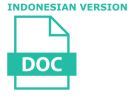Pembentukan Kalimat Pasif Bahasa Jepang: Studi Kasus Pembelajaran Kalimat Pasif Bahasa Jepang Pada Pembelajar Indonesia
Rani Arfianty(1*), Adriana Hasibuan(2)
(1) Universitas of Sumatera Utara
(2) Universitas of Sumatera Utara
(*) Corresponding Author
Abstract
This study aims to analyze the errors in the construction of Japanese passive sentence. This research involves Indonesian Japanese language students of semester IV. The sample of this research is Indonesian essay in 200 words. Quantitative and qualitative methods are used based on the error establishment definition of Japanese passive sentence Ichikawa (2005). The research result shows that the students make mistake in changing the Japanese passive verb form by 53%, the error in particle selection as much as 24%, the error in the subject structuring and object complement 18% and error in sentence formation of Yari-morai (giving-taking) as much as 5%. The error in changing the Japanese passive verb form is caused by a lack of practice and understanding of Japanese passive forms. Error in particle selection is caused by negative transfer factor. The lack of students 'understanding of the formation of Japanese passive sentences causes learners to tend to arrange subjects and principals' objects in Japanese passive sentences following the Indonesian passive sentence arrangement rules. The results of this study can provide an overview for Japanese language teachers, especially about the acquisition of learning passive Japanese sentence language among Indonesian students to be able to make a variety of a more creative teaching.
Keywords
Full Text:
PDFReferences
Brown, J. D, & Rodgers, T. S. (2002). Doing Second Language Research. New York: Oxford University Press.
Dulay, H.C., Burt, M. & Krashen, S.(1982). Language Two. New York: Oxford University Press.
Hama Y. (2005). Indonesia Kara Rainichi shita Shokyuu Nihongogakushuusha ni okeru Goyou Bunseki = Error analysis on Beginners Japanese Language Learners from Indonesia – Bachelor Thesis, Departement of Language Education, Faculty of International Studies. Obirin University. Japan.
Hamidi, A.S, & Baharuddin, E. (2014). Metode Penelitian Kuantitatif Aplikasi dalam Pendidikan. Deepublish: Yogyakarta.
Haslina, H,dan Hasuria Che Omar. (2013). Asas Terjemahan dan Interpretasi. Pulau Pinang: Penerbit USM.
Harmer, J. (2001). The Practice of English Language Teaching. England: Pearson Education Limited.
Halim, H. A., Hoon, A. L. (2015). Kesalahan Pemilihan dan Pembentukan kata dalam Terjemahan Bahasa Perancis. GEMA Online® Journal of Language Studies.15(2), 151-164 http://ejournal.ukm.my/gema/article/view/7921
Ichikawa, Y. (2005). Shokyuu Nihongo Bunpou to Oshiekata no Pointo = Point of Basic Japanese Grammar and Teaching. Japan: Surii ee network.
______. (1997). Nihongo Goyou Youreibun Kojiten = A Dictionary of Japanese Errors. Tokyo: Bojinsha.
Moentaha Salihen. (2006). Bahasa dan Terjemahan. Jakarta: Kesaint Blanc.
Odlin Terence. (1993). Language Transfer—Cross – Linguistic influence in Language Learning, In Long, M and Richards Jack (Eds.). New York: Cambridge University Press.
Ozeki H. (2010). Nihongo o Oshieru tame no Dai Ni Gengogaku Shutokuron Nyuumon = An Introduction to Second Language Acquisition for Japanese Teaching. Japan: Kuroshio.
Risda D. (2009). Kesalahan Penggunaan Ukemi dari Pembelajar bahasa Jepang, data diambil dari karangan Mahasiswa Indonesia. Jurnal Bahasa Jepang, Vol 1 No 1, 13-23. Bandung: ASPBJI & The Japan Foundation Jakarta.
Yoshikawa, T. (1982). Nihongo Goyou Bunseki : Japanese Error Analysis. Japan: Meiji Shoin.
Article Metrics
Refbacks
- There are currently no refbacks.
Copyright (c) 2018 The Author(s)

This work is licensed under a Creative Commons Attribution-ShareAlike 4.0 International License.







